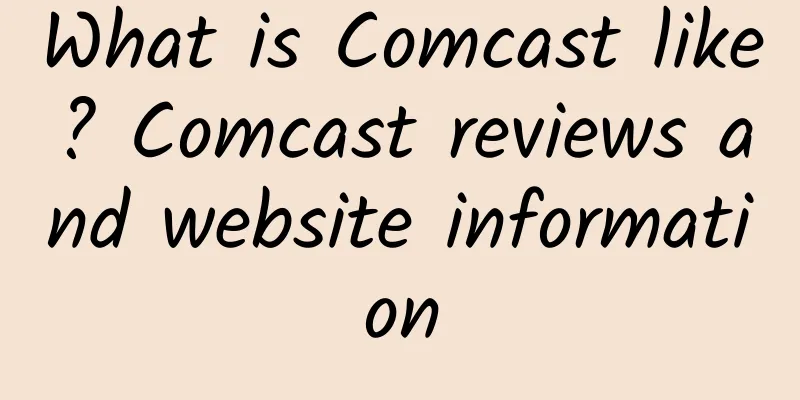What is Comcast like? Comcast reviews and website information

|
What is Comcast? Comcast is the largest cable TV provider and the second largest Internet provider in the United States, headquartered in Philadelphia, Pennsylvania. Comcast's portal is primarily operated by its Interactive Media Division. Comcast currently provides cable and broadband services to more than 21 million customers in 35 states and the District of Columbia. Comcast's customer base includes more than 9.4 million digital video customers, more than 8.1 million high-speed data customers, and more than 1.2 million wired telephone users, making Comcast a leader in eight of the top ten markets in the United States. Website: www.comcast.net Comcast: America's leading cable TV and Internet service providerIn today's digital age, high-quality network connections and diverse entertainment content have become necessities of modern life. As the largest cable TV provider and the second largest Internet service provider in the United States, Comcast occupies a pivotal position in the communications and media industries with its excellent services and wide coverage. Headquartered in Philadelphia, Pennsylvania, Comcast not only provides reliable services to millions of American households, but also operates portal websites through its interactive media division, and is committed to building a comprehensive digital ecosystem. Since its inception, Comcast has always been customer-centric and has continuously expanded its business scope and service quality. Currently, Comcast provides cable TV, broadband Internet and telephone services to more than 21 million customers in 35 states and the District of Columbia. Its huge customer base includes more than 9.4 million digital video customers, more than 8.1 million high-speed data customers and more than 1.2 million wired telephone users. With its strong market influence, Comcast ranks among the top eight in the top ten markets in the United States, becoming one of the preferred service providers for consumers. This article will take an in-depth look at Comcast’s historical background, core business, technological innovation, and future development direction to help readers fully understand how this industry giant shapes the digital experience of modern families. History and Development of ComcastComcast was founded in 1963 as American Cable Systems, a small company specializing in cable television. After decades of development and a series of strategic acquisitions, Comcast has gradually grown into a leading global communications and media company. In 1999, the company was renamed Comcast Corporation and began to expand its service scope, transforming from a simple cable television provider to a comprehensive operator integrating television, Internet and telephone services. In 2001, Comcast completed the acquisition of AT&T Broadband, which made it the largest cable TV company in the United States. Subsequently, Comcast acquired a portion of NBCUniversal in 2011, further consolidating its position in the media industry. In 2013, Comcast fully controlled NBCUniversal, marking the company's official entry into the content production field. Today, Comcast is not only a technology-driven service provider, but also a comprehensive enterprise with strong media resources. As digital transformation accelerates, Comcast continues to increase its investment in infrastructure and technology research and development. In recent years, the company has launched the Xfinity brand, which aims to integrate all its services and provide customers with a more convenient and personalized experience. In addition, Comcast is also actively developing smart home solutions, such as smart home devices and voice control functions, to meet the growing needs of modern consumers. Comcast's Core BusinessAs a diversified enterprise group, Comcast's core businesses are mainly concentrated in three areas: cable TV, broadband Internet and telephone services. These businesses together constitute Comcast's service system, providing users with comprehensive digital life solutions. 1. Cable TV Service Comcast is the largest cable TV provider in the United States. Its digital video services cover 35 states and the District of Columbia, with more than 9.4 million subscribers. Through the Xfinity X1 platform, Comcast provides users with high-definition picture quality, rich channel selection and advanced interactive functions. The X1 platform supports voice search, personalized recommendations and multi-screen viewing, which greatly improves the user experience. In addition, Comcast has also partnered with a number of well-known content providers to ensure that users can watch the latest movies, TV series and sports events. Whether it is a home theater-like viewing experience or real-time tracking of favorite team games, Comcast can meet the diverse needs of users. 2. Broadband Internet Service As the second largest Internet service provider in the United States, Comcast provides high-speed data connections to more than 8.1 million users. Its Xfinity Internet service is known for its stability and speed, with download speeds up to gigabit. This high-performance network connection is not only suitable for daily Internet browsing, but can also easily handle high-bandwidth requirements such as online games, video conferencing and streaming media. In order to meet the needs of different users, Comcast provides a variety of package options, including affordable basic plans and high-end plans designed for enterprises. Whether working, studying or entertaining at home, Comcast can provide users with the best network experience. 3. Telephone service In addition to cable TV and Internet services, Comcast also provides wired telephone services to more than 1.2 million customers. Through the Xfinity Voice platform, customers can enjoy unlimited local and long-distance calls, free international calls, and a variety of value-added features such as caller ID, voicemail, and call forwarding. It is worth mentioning that Comcast's phone service is seamlessly integrated with its other services, and users can manage all services through a single account, greatly simplifying the usage process. In addition, Xfinity Voice also supports interconnection with other devices, such as remotely controlling the landline at home through a smartphone application. Comcast's Technological InnovationAs a leading technology company, Comcast has always been committed to promoting technological innovation to improve service quality and explore new business areas. In recent years, the company has made significant progress in the following areas: 1. Smart Home Solutions Comcast provides users with a series of smart home devices and services through the Xfinity Home platform. These devices include smart thermostats, security cameras, door lock controllers and lighting control systems, which can help users achieve home automation management. Through mobile phone applications or voice assistants, users can monitor and control various facilities in their homes anytime and anywhere, thereby improving the convenience and safety of life. In addition, Comcast has launched the Xfinity xFi platform, which allows users to fine-tune the management of their home network. Users can use the app to view device connections, set parental control rules, and optimize network performance to ensure that every corner can enjoy a stable Wi-Fi signal. 2. Cloud computing and big data analysis In order to better understand customer needs and optimize resource allocation, Comcast has invested heavily in cloud computing and big data analysis technologies. By collecting and analyzing massive amounts of user data, Comcast is able to identify potential trends and patterns, thereby providing strong support for product development and marketing decisions. At the same time, Comcast also uses cloud computing technology to support its content distribution network (CDN), ensuring that users can smoothly access online videos and other multimedia content at any time and any place. This efficient cloud architecture not only improves user experience, but also reduces operating costs. 3. 5G network deployment With the rapid development of 5G technology, Comcast is actively involved in research and practice in related fields. The company plans to gradually launch 5G fixed wireless access (FWA) services in the next few years to provide high-speed Internet access to areas that cannot obtain traditional fiber connections. This technology will greatly improve network coverage in rural and remote areas and narrow the digital divide. In addition, Comcast is also exploring the potential of 5G in emerging fields such as augmented reality (AR), virtual reality (VR) and the Internet of Things (IoT). By developing innovative solutions with partners, Comcast hopes to take a leading position in the next generation of communication technology. Comcast's Market Performance and Competitive AdvantagesAs one of the leading companies in the US communications and media industry, Comcast has performed well in the market. According to the latest financial report data, the company has achieved sustained growth in the past few quarters, with both revenue and profit exceeding expectations. This strong performance is due to its extensive service portfolio, large customer base and expanding market share. Comcast's competitive advantages are mainly reflected in the following aspects: 1. Strong brand influence After years of accumulation, Comcast has established a brand image that is deeply trusted by consumers. Its Xfinity brand has become synonymous with high-quality services and advanced technology, winning the recognition and support of countless users. 2. Comprehensive service integration Comcast's biggest advantage over its competitors is that it can provide a one-stop solution. Whether it is home entertainment, Internet connection or telephone communication, users can manage all services through a single account and enjoy a seamless experience. 3. Continuously innovative products and technologies Comcast has always been highly sensitive to new technologies and actively applied them to its actual business. Whether it is smart home devices, cloud computing platforms or 5G networks, Comcast is striving to stay at the forefront of the industry and bring more value to users. 4. Extensive geographical coverage Comcast's service network covers 35 states and the District of Columbia in the United States. This wide geographical coverage enables it to reach more potential customers and expand its market influence. Comcast's Future OutlookLooking ahead, Comcast will continue to move forward along its established strategic direction and strive to build a more intelligent and personalized digital ecosystem. The company will focus on the following key areas: 1. Expanding 5G network coverage As 5G technology becomes more popular, Comcast will further accelerate the deployment of its fixed wireless access services, striving to provide ultra-high-speed Internet connections to more users. At the same time, the company will also actively explore the application scenarios of 5G in vertical industries, such as smart cities, industrial automation and telemedicine. 2. Strengthen content production and distribution capabilities As the parent company of NBCUniversal, Comcast will continue to increase its investment in original content and launch more high-quality film and television works. Through the Peacock streaming platform, the company hopes to attract more subscribers and promote its brand globally. 3. Promote sustainable development Comcast is committed to implementing environmental protection in its operations, reducing carbon emissions and improving energy efficiency. The company plans to achieve 100% renewable energy supply in the next few years and reduce its overall environmental impact through technological innovation. 4. Improve customer service experience Finally, Comcast will continue to optimize its customer service process to ensure that every user can get satisfactory support. By introducing artificial intelligence technology and automation tools, the company hopes to respond to customer needs faster and provide more accurate solutions. In short, Comcast is steadily moving toward its goal of becoming the world's leading digital life service provider. With its strong strength, keen insight and firm determination, I believe this company will continue to lead the industry development trend in the future. ConclusionAs the largest cable TV provider and the second largest Internet service provider in the United States, Comcast has become an indispensable part of modern families. From its initial cable TV start to a comprehensive enterprise covering multiple fields such as broadband Internet, telephone services and smart home solutions, Comcast has always been customer-oriented and continuously innovated and developed. In the future, with the widespread application of new technologies such as 5G, cloud computing and artificial intelligence, Comcast will surely bring us more surprises and help realize a better digital life. |
>>: How is Cerro Rosa Paper? Cerro Rosa Paper Reviews and Website Information
Recommend
The nutritional value of purple lettuce leaves and the benefits of eating purple lettuce leaves
Some people may have eaten purple lettuce and kno...
The medicinal value and efficacy of leek seeds
Many people know about leek seeds. They are the s...
How to make eel soup? The benefits of eel soup
Eel is a kind of fish with high nutritional value...
Is it good to drink lemon water? The effects and functions of lemon water
Lemon is one of the specialty fruits of the south...
The difference between gold and sand
Both gold and sand are golden, and they can be us...
How to eat wild mushrooms? The best way to eat wild mushrooms
Wild mushrooms mostly grow in mountain forests. T...
The efficacy and function of loofah water
Luffa water is the toner we often use when cleans...
Dietary taboos for gastroenteritis What foods should not be eaten for gastroenteritis
Gastroenteritis is a common disease in life, and ...
Which walnut has high nutritional value
Walnut is a food with particularly high nutrition...
What is Sony Pictures Classics like? Sony Pictures Classics reviews and website information
What is the website of Sony Pictures Classics? Son...
Yongquan mandarin orange origin_effects and functions
I believe many of my friends have eaten Yongquan ...
Ingredients and preparation of papaya and red dates drink
Have you ever tried papaya and red dates drink? T...
How to make wild rice stems delicious
Wild rice has tender meat, attractive taste and r...
What is Myvitamins? Myvitamins review and website information
What is Myvitamins? Myvitamins is a well-known Bri...
What are the benefits of foot massage?
In life, some people who like to keep healthy wil...









